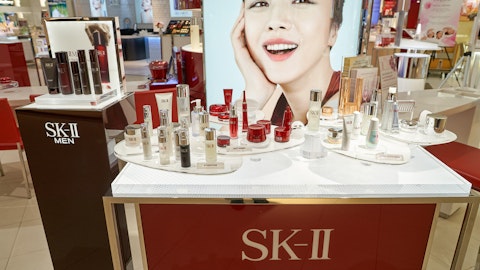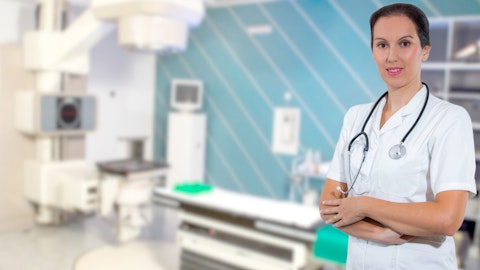InMode Ltd. (NASDAQ:INMD) Q4 2023 Earnings Call Transcript February 13, 2024
InMode Ltd. beats earnings expectations. Reported EPS is $0.71, expectations were $0.68. InMode Ltd. isn’t one of the 30 most popular stocks among hedge funds at the end of the third quarter (see the details here).
Operator: Good day, and welcome to the InMode’s Fourth Quarter and Full Year 2023 Earnings Conference Call. [Operator instructions] Please note, this event is being recorded. I would now like to turn the conference over to Miri Segal of MS-IR. Please go ahead.
Miri Segal: Thank you, operator, and to everyone for joining us today. Welcome to InMode’s fourth quarter and full year 2023 earnings call. Before we begin, I would like to remind, our listeners that certain information provided on this call may contain forward-looking statements, and the safe harbor statement outlined in today’s earnings release also pertains to this call. If you have not received a copy of the release, please go the Investor Relations section of the company’s website. Changes in business, competitive, technological, regulatory, and other factors could cause actual results to differ materially from those expressed by the forward-looking statements made today. Our historical results are not necessarily indicative of future performance.
As such, we can give no assurance as to the accuracy of our forward-looking statements and assume no obligation to update them, except as required by law. With that, I’d like to pass the call over to Moshe Mizrahy, Chairman and CEO. Moshe, please go ahead.
Moshe Mizrahy: Thank you, Miri, and to everyone for joining us. With me today are Dr. Michael Kreindel, our Co-Founder and Chief Technology Officer; Yair Malca, our Chief Financial Officer; Shakil Lakhani, our President in North America; and Rafael Lickerman, our VP of Finance. Following the prepared remarks, we will all be available to answer your question. The second half of 2023 presented challenges for InMode for their aesthetic industry as all and to the aesthetic — and to the surgical aesthetic sector in particular. In the fourth quarter, we revised our guidance for the first time in the history of the company due to the increased impact of the industry slowdown. This resulted in 5% year-over-year decline in Q4 revenue, which amounted to $126.8 million.
However, we are pleased to have grown our full year revenue to a record of $492 million, reflecting an 8% increase compared to the full year of 2021. We take pride in being the only company in the industry that consistently generate over $100 million per quarter, demonstrating growth even in the face of a challenging year. Moreover, we keep our gross margin the highest in the industry, strong and steady at 84% for both Q4 and the full year, all while maintaining our established price structure for the platforms and for the consumable. As previously mentioned, over 80% of the platform sales are facilitated through leasing agreement, higher interest rate and longer lending approval cycles have impacted InMode overall growth rate. This macroeconomic environment has also affected patients who are more sensitive to the price of the aesthetic treatment, resulting in lower underlying demand for our minimally invasive treatment.
To address these challenges, we are in the process of establishing approval program with financial institution to improve and expedite the credit decision process. In some cases, we directly leverage our strong balance sheet to support physicians by providing financing option ourselves. Additionally, capitalizing on this lower year and our robust balance sheet, in 2023, we expanded our R&D activity by hiring more engineers and recruiting training professional. Also, we increased our sales team in our subsidiaries, expedited international expansion and increased investment in worldwide regulatory pathway. During 2023, we introduced 2 successful new platforms, Envision for the ophthalmology market and Define for the hands free aesthetic market, which is the next generation of Evoke.
We are encouraged by the results from the soft launch of our Envision platforms last year, and we expect Envision to expand outside the U.S. during 2024. InMode continue to innovate, bringing new and exciting products to the market. In 2024, we plan to launch 2 new platforms, offering significant improvement in technology and energy levels, along with the new technology for our minimal invasive treatment and for Morpheus8. Finally, we remain committed to supporting all customers, distributors, employees, salespeople worldwide. Regarding the situation in Israel, we could like – we would like to reiterate that we have established a contingency plan with sufficient inventory globally, including in Israel in the U.S. and in Europe. We continue to closely monitor the situation and are pleased to report that we are conducting business as usual.

Now I would like to turn the call over to Shakil, our President in North America. Shakil?
Shakil Lakhani: Challenges in North America during the fourth quarter, despite the headwinds of lower platform sales, we are reporting a 20% increase in consumable and service sales in Q4. Consumables and service revenue accounted for 16% of total Q4 revenues. As Moshe mentioned, we are pleased with the successful launches of Envision and Define. Both platforms have made significant progress in North America, gaining traction amongst practices and patients. Considering the anticipated slower market demand this year, we’ve implemented changes within our sales team in North America. We’ve adjusted our infrastructure to position ourselves for accelerated growth when market conditions improve. Lastly, I’d like to thank our entire North American team for their continued hard work. I will now hand over the call to Yair for review of the financial results in more detail. Yair?
Yair Malca: Thanks, Shakil, and hello, everyone. Thank you for joining us. Starting with total revenue, InMode generated $126.8 million in the fourth quarter of 2023 with a gross margin of 84% on a GAAP basis. For full year 2023, revenue totaled a record $492 million, an increase of 8% compared to 2022. Non-GAAP gross margins remained the highest in the industry and within our target range at 84% for both the fourth quarter and the full year of 2023. In Q4 and in the full year of 2023, our minimally invasive technology platforms accounted for 83% of total revenues. For the full year of 2023, consumable accounted for 16% of revenue, an increase from 13% in 2022. Moving to our international operations. Fourth quarter sales outside the U.S. accounted for $46 million or 36% of sales, a 9% increase compared to Q4 last year.
For full year of 2023, sales outside the U.S. accounted for $184.2 million or 37% of sales, an 18% increase compared to 2022. InMode now operates in a total of 96 countries. Among our global contributors, Asia and Europe were the primary drivers fueling our growth rate. To support our operations and growth, we currently have a sales team of more than 256 direct reps and 82 distributors worldwide. GAAP operating expenses in the fourth quarter were $55.3 million and $215.7 million for the full year, a 5% and an 18% increase year-over-year, respectively. Sales and marketing expenses increased slightly to $49.5 million in the fourth quarter compared to $47 million in the same period last year. Sales and marketing expenses for the full year of 2023 were $193 million compared to $160.6 million for 2022.
This increase is attributed to hiring more sales representatives, increasing our presence in the U.S. and globally. Next, we look at share based compensation, which decreased to $6.3 million in the fourth quarter of 2023 and $23.6 million in the full year of 2023. On a non-GAAP basis, operating expenses were $49.5 million in the quarter compared to a total of $46.1 million in the same quarter of 2022, representing a 7% increase. For 2023, non-GAAP operating expenses were $194.1 million compared to $160.4 million for 2022. GAAP operating margin for Q4 and for 2023 was 40%. Non-GAAP operating margins for the fourth quarter and for full year 2023 was 45% compared to 50% and 49% for the fourth quarter of 2022 and full year 2022. GAAP diluted earnings per share for the fourth quarter was $0.64 compared to $0.44 per diluted share in Q4 of 2022 and $2.30 in 2023 compared to $1.89 in 2022.
Non-GAAP diluted earnings per share for this quarter were $0.71 compared to $0.78 per diluted share in the first quarter of 2022 and $2.57 for 2023 compared to $2.42 for 2022. Once again, we ended the quarter with a strong balance sheet. As of December 31, 2023, the company had cash and cash equivalents, marketable securities and deposits of $741.6 million. This quarter, InMode generated $61.2 million from operating activities. Before I turn the call back to Moshe, I’d like to reiterate our guidance for 2024. Revenues between $495 million and $505 million, non-GAAP gross margins between 83% and 85%, non-GAAP income from operations between $217 million and $222 million, non-GAAP earnings per diluted share between $2.53 and $2.57. I will now turn over the call back to Moshe.
Moshe Mizrahy: Thank you, Yair. Thank you, Shakil. Operator, we are ready for Q&A, please.
Operator: Thank you. We will now begin the question-and-answer session. [Operator Instructions] Our first question today comes from Matt Miksic with Barclays. Please go ahead.
See also 15 Worst Airports in the U.S. for Connecting Flights and 15 Highest Quality Pasta Brands In The US.
Q&A Session
Follow Integramed America Inc (NASDAQ:INMD)
Follow Integramed America Inc (NASDAQ:INMD)
Matt Miksic: Hi, good morning. Thanks so much for taking the question. And I appreciate all the color. I wanted to maybe start off with just if you could talk a little bit about what you’re assuming in your current 2024 revenue guide? And what kind of indication that you’ve seen since December and early January to the trajectory of some of the major factors driving your current outlook for 2024?
Moshe Mizrahy: Yes. Thank you for the question. Well, as you can see, we try to be – this is Moshe. We try to be very conservative. What happened in the 6 – in the last 6 months of 2023 in the macroeconomics, with the interest rate, with all the leasing problems that we encounter, it’s continuing in Q1. It’s not over yet. We don’t know when – what will happen during the quarters of 2024. We read a lot of macroeconomics studies and research. And we understand that it might better – it might get better in the second half of the year. And therefore, we have decided to be very conservative in the guidance. We want to meet the guidance and not change it like we did in the last 6 months – in the last 3 months of 2023. What we see in December and January is continued the situation that exists in the last 6 months of 2023.
We don’t see any positive sign yet in the terms and the obstacles that we saw in the last 6 months of 2023. And therefore, I mean, we will not change it until we will be absolutely sure that we can meet the guidance that we will give. I don’t know if I answered your question, but that’s the situation currently.
Matt Miksic: Yes. No, that’s helpful. And then secondly, you mentioned a couple of new platforms that you’re launching this year. And if we are going to think about sort of the cadence for the year and the potential for things to sort of stabilize and start to improve, what kind of factor might those play? Are those back-end loaded effect? And any additional color that you can share on those or any other actions you’re able to take to sort of offset some of the market dynamics you’re describing? Thanks.
Moshe Mizrahy: Okay. Basically, the 2 platforms that we will introduce in 2024 our second-generation technology for the minimal invasive, the RFAL, Radio-Frequency Assisted Liposuction and the Morpheus8 technology. These are basically the 2 main lines of the surgical part of our portfolio. We have developed a very unique and very, I would say, breakthrough technology for new minimal invasive to be able to do plastic surgery with one incision point with revolutionary hand pieces. And we have improved dramatically the performance of the Morpheus8, which is, as everybody know, one of the biggest brand name in the medical aesthetic. Both will come during the year when the final tuning of completing the R&D, the studies and the regulation for them.
We will introduce them to the market, not in Q1, but I would say more like end of Q2, beginning of Q3. And we believe that they will add to our revenue in the second half of the year. Of course, taking into consideration is that the situation, the macroeconomics and the situation in the last 6 months of 2024 will get better. As far as R&D, we’re not slowing down. There is no slowdown in R&D in InMode. We continue to develop business as usual, and we will be – we will continue to bring 2 new platforms, 2 new indications either in the aesthetic field or in the ophthalmology, women health with Empower. We have currently a pipeline of more than 5 major new platforms that we will bring to the market in the next few years. I mean this is our bread and butter here in Israel, and we will continue to develop products and bring new to the doc – bring new stuff to the doctor and to the patient.
Matt Miksic: Very helpful. Thanks so much for the color.
Operator: Our next question is from Matt Taylor with Jefferies.
Mike Sarcone: Hey, good morning. This is Mike Sarcone on for Matt Taylor. And thank you for taking my question. So just to start, a follow-up on the guidance question. You talked about it from the macro perspective and some of the newer systems slated for 2024. So could you give any color on how you’re thinking about contribution from Envision and the new Define system as you’re thinking about 2024?
Moshe Mizrahy: Yes, yes. First, I want to say something, Matt. The macro analysts of Jefferies was the only one who predicted that the economy will start to do slow down in the third quarter of 2023, and he was absolutely right. I read his microeconomics study and research in the beginning of the year and he was quite right. Regarding the Envision, the Envision was launched to the market in the middle of the second quarter in the United States, and we did well until the end of the year, we sold close to $30 million of this platform in 2.5 quarters. So we’re very, very encouraged, very, very encouraged. We see that the doctors and the users are happy with the results. And we believe that the momentum will continue in 2024. We also intend to bring these platforms to Europe.
We introduced the platforms during the distributor meeting in Paris during the IMCAS show days ago, close to 10 days or 2 weeks ago. And everybody was excited. We need to find the wide distributors in Europe and train our salespeople in the subsidiaries that we have in Europe, so they can handle and sell this platform. We intend to bring some doctors from the United States and Canada who are luminary for us in this particular category, ophthalmology and bring them to do workshop in Europe so we can expedite the penetration process, but we’re very encouraged with Envision. As regard to the Define, as you know, the first generation of the Define was the Evoke which was very successful when it was introduced during the COVID time because it enabled the doctor to do social distancing treatment without being in the room.
But 2 years after, we decided that we want to improve this platform and bring something a little bit more, I would say, well designed, especially with the mask that we put on the face and we redesigned it and we added to the platform Morpheus for the face, so the doctor can complement the hand-free treatment with Morpheus face, which everybody knows that the results are great. We develop a combination treatment for both the hand-free and the Morpheus for these platforms. We introduced all this during the sales meeting of North America in the beginning of – at the end of January, and it was well accepted. We believe that right now, we start to penetrate the market with the new protocol and the new device. I mean, it’s a hand free, hand free, it’s not the highest technology or the best seller of InMode because hand free was never best seller.
It’s a complementary product. But I believe that this complementary product is the best in the market as far as the hand free category. Did I answer you, Matt?
Mike Sarcone: You did, Moshe. Thank you very much. And then just one more question. You talked about baking in continuation of these macro headwinds into guidance. And you also mentioned you’re in the process of establishing an approval program to expedite the credit process and maybe use some of InMode’s balance sheet. Can you just talk about kind of where you stand in that process in terms of when does that get off the ground and where you’re going to focus that geographically? And if that starts to make some headway or it becomes effective, can that drive upside to how you’re thinking about 2024 sales or guidance right now?
Yair Malca: Yes. This is Yair. Right now, I would say it is baked into our guidance already. We have a couple of programs, one in the U.S. and one outside of the U.S., and we are looking to expand those. Basically, what we are doing is some sort of risk-sharing mechanism where we can take a very small portion of the risk of – from the – our leasing partners, and that would give them the incentives to what we call buy deeper and provide approval quicker. And I think that’s definitely going to help us. But as we mentioned, there is also some slowdown in the demand in the underlying market. And again, this will not help with this portion. So overall, we already implemented a couple of programs, and we plan to expand those. However, this is already baked into the guidance, at least at the moment.
Mike Sarcone: Okay, great. Thank you, Yair.
Operator: Our next question comes from Danielle Antalffy with UBS.
Danielle Antalffy: Thank you so much. Good morning, everyone. Thanks for taking the question. Just Yair and Moshe, on the underlying demand component here. Just curious, I know, Moshe, you mentioned January so far you haven’t seen an improvement. I just want to confirm that that’s true of the underlying demand as well. And I would just love to hear how you guys think about the sort of drivers of improving demand. Like what should we be looking for as it relates to the economy that could signal a potential uptick in improving demand? That’s the first part of my question. And then the second part of your question, given that this is a capital business, how much of a lag is there once we see improving demand, like do people start purchasing equipment more readily 3 months later, 6 months later, is it right away? Would just love some color on how to think about that? Thanks so much.
Moshe Mizrahy: Okay. Well, I will reiterate what I said. Right now, in the months of December and January, we do not see any change in the outlook of the macro situation. Whether or not we can see 3 months in advance, we don’t know. And I don’t think that anybody can answer that. We see some slowdown, not just in the equipment sales, but also we see some slowdown in the disposable sales because we believe that the slowdown affect the consumer as well and less people are going right now to do minimal invasive procedures, which is a little bit more effective than non-invasive procedure these days. So the only thing that we can say is we expect some improvement in the situation of the macro look sometime in the second half of the year, not in the first year of the year.
We see the same process happening in Europe right now, especially in the major countries. The inflation in the United States already went down a little bit, but in Europe, not yet. And therefore, the process there will take some more time. But we are basically evaluating the situation on a daily basis, almost on a daily basis. We see the behavior of the leasing company. And this is something that tell us exactly what’s going in the market. The leasing companies right now are very tough in the time that take them to clear a transaction and also the interest rate that they are requiring and also the process and what kind of deals they expect to get and what kind of deal they don’t want to get. So I mean we are monitoring it. So far, we don’t see any sign of improvement.
But hopefully, we can start seeing it at the end of the second quarter.
Danielle Antalffy: Okay. That’s helpful. And then you obviously have a very strong balance sheet. I appreciate the work you’re doing to help take on risk as well. I assume that doesn’t preclude you from continuing to search for potential M&A opportunities, as you can say on where you guys stand there? I mean, it feels like the market might be right given the difficulties and you guys are in a strong position there. Thanks so much.
Moshe Mizrahy: We’re currently exploring a potential candidate for M&A, something that complement our portfolio, not a laser company, by the way. It’s a company that also are in the aesthetic field, but not similar to us. We’re in the very early stage of evaluating the company. We don’t have any bank, we’re doing it ourselves. And we will know better sometime in the month – in the beginning of March, whether it’s – we can go to the next practical step or not. That’s all what we do right now. As I said before, the Board of Directors decided not to do buyback because of many reasons that I have explained before, but rather to keep the money to try to do M&A, more strategic M&A, which we believe will benefit the company much better than buying our own stock.
So this is the situation. I mean I have to say something, the macroeconomics did not help to the M&A, I would say, process because all the sellers are waiting to see that the market will improve, maybe they can get a better price for their assets. And – but that’s the situation. We cannot help it. But as I said, we’re exploring one opportunity right now.
Danielle Antalffy: Thank you so much. Great color.
Operator: And our next question comes from Mike Matson with Needham & Company.
Mike Matson: Good morning. Thanks for taking my questions. Just wanted to start with kind of a quarterly sequencing in 2024. So can you comment on whether or not you’re comfortable with consensus in the first quarter? I think it’s around $100 million or so?
Moshe Mizrahy: We do not give guidance per quarter. We only give guidance per year, and we are updating the – we’re updating the guidance if we’re updating the guidance, not always at the end of each quarter based on the performance of the quarter and what we see forward. And therefore, we will not comment on any guidance on the first quarter. But as you know, this industry is – there has some seasonality. The fourth quarter is the strongest one. The third quarter is the slowest one because of the summer. The second quarter is also strong, and the first quarter is in between. But during the last few years, because of the COVID and because of some other reason, the seasonality did not exactly was the same as years ago. And therefore, we don’t know what will happen in 2024. And therefore, guidance per quarter is not something that we provide.
Mike Matson: Okay. I understand. And then your commentary around the patient demand. From what I remember, I don’t remember you talking about that as much or commenting on that. I seem to remember the focus in the prior couple of quarters about the challenges you’re facing being more kind of focused on the financing conditions, both interest rates and just tighter lower financing in general. So more on kind of the physician side of things. Am I correct in interpreting this patient demand issue as being something kind of a newer headwind? Or was that there all – has that been there all along?
Moshe Mizrahy: Well, you know, we have to distinguish between non-invasive treatment and minimal invasive treatment, okay? Non-invasive treatment like hair removal, pigmentation, all kind of topical treatment, these treatments are type of commodity, the cost is not very high. And I don’t know, just because we’re not exactly in this type of business, only 10% of our products are commodity type. I don’t know how much this segment of the market was affected. The minimal invasive, mainly, the minimal invasive radio-frequency-assisted lipolysis, mean doing some kind of plastic surgical procedure with one incision point with all the benefit that we have presented to the market. And the Morpheus8, which is also surgical because it’s penetrate the skin up to 7-millimeter deep, are not cheap procedures.





